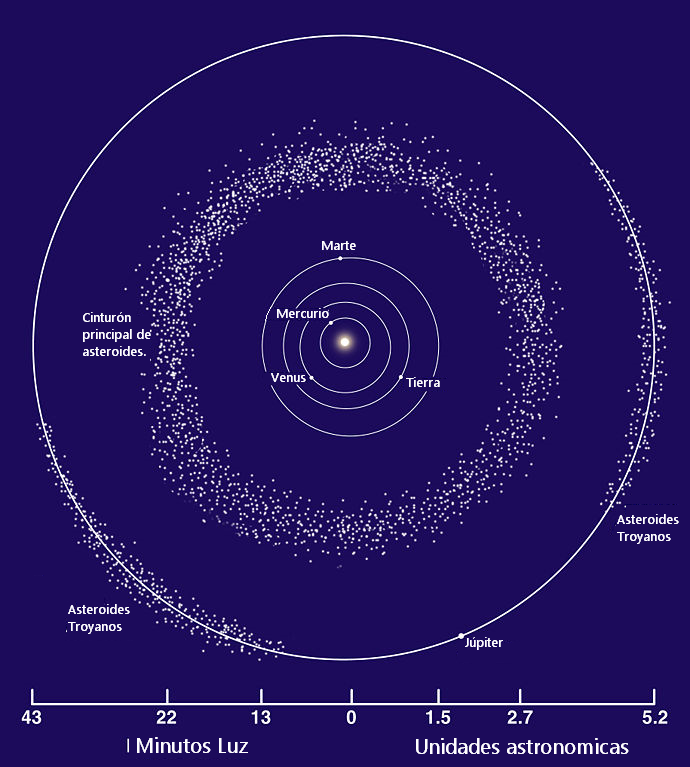Hola amigos: A VUELO DE UN QUINDE EL BLOG., la Agencia Espacial NASA, nos informa que la nave : NASA's Dawn spacecraft, ha captado la imagen del planeta enano o asteroide Ceres, que se encuentra en la órbita de Marte y Júpiter, que ha sido enfocado por ambas caras, está ubicado el llamado : Cinturón de Asteroides, siendo Ceres el más grande de los todos los asteroides del Sistema Solar.

Comparación de Ceres entre La Tierra y la Luna (Wikipedia.

Imagen esquemática del cinturón de asteroides. Se muestra el cinturón principal, entre las órbitas de Marte y Júpiter, y el grupo de los troyanos, en la órbita de Júpiter
El cinturón de asteroides es una región del Sistema Solar comprendida aproximadamente entre las órbitas de Marte y Júpiter. Alberga multitud de objetos irregulares, denominados asteroides, y al planeta enano Ceres. Esta región también se denomina cinturón principal con la finalidad de distinguirla de otras agrupaciones de cuerpos menores del Sistema Solar, como el cinturón de Kuiper o la nube de Oort.
Wikipedia.

Dawn Approaches: Two Faces of Ceres
These two views of Ceres were acquired by NASA's Dawn spacecraft on Feb. 12,
2015, from a distance of about 52,000 miles (83,000 kilometers) as the dwarf
planet rotated. The images have been magnified from their original size.
The Dawn spacecraft is due to arrive at Ceres on March 6, 2015.
Dawn's mission to Vesta and Ceres is managed by the Jet Propulsion Laboratory
for NASA's Science Mission Directorate in Washington. Dawn is a project of the
directorate's Discovery Program, managed by NASA's Marshall Space Flight Center
in Huntsville, Alabama. UCLA is responsible for overall Dawn mission science.
Orbital ATK, Inc., of Dulles, Virginia, designed and built the spacecraft. JPL
is managed for NASA by the California Institute of Technology in Pasadena. The
framing cameras were provided by the Max Planck Institute for Solar System
Research, Göttingen, Germany, with significant contributions by the German
Aerospace Center (DLR) Institute of Planetary Research, Berlin, and in
coordination with the Institute of Computer and Communication Network
Engineering, Braunschweig. The visible and infrared mapping spectrometer was
provided by the Italian Space Agency and the Italian National Institute for
Astrophysics, built by Selex ES, and is managed and operated by the Italian
Institute for Space Astrophysics and Planetology, Rome. The gamma ray and
neutron detector was built by Los Alamos National Laboratory, New Mexico, and is
operated by the Planetary Science Institute, Tucson, Arizona.
Image Credit:
NASA/JPL-Caltech/UCLA/MPS/DLR/IDA
Dawn Delivers New Image of Ceres
The Dawn spacecraft observed Ceres for an hour on
Jan. 13, 2015, from a distance of 238,000 miles (383,000 kilometers). A little
more than half of its surface was observed at a resolution of 27 pixels. This
animated GIF shows bright and dark features.
Image Credit:
NASA/JPL-Caltech/UCLA/MPS/DLR/IDA/PSI
This is a zoomed-in raw image, taken Jan. 13, 2015,
showing the dwarf planet Ceres as seen from the Dawn spacecraft on its approach.
Surface features have started to become apparent in the image. Dawn's framing
camera took this image at 238,000 miles (383,000 kilometers) from
Ceres.
Image Credit:
NASA/JPL-Caltech/UCLA/MPS/DLR/IDA
As NASA's Dawn spacecraft closes in on Ceres, new images show the dwarf
planet at 27 pixels across, about three times better than the calibration images
taken in early December. These are the first in a series of images that will be
taken for navigation purposes during the approach to Ceres.
Over the next several weeks, Dawn will deliver increasingly better and better
images of the dwarf planet, leading up to the spacecraft's capture into orbit
around Ceres on March 6. The images will continue to improve as the spacecraft
spirals closer to the surface during its 16-month study of the dwarf planet.
“We know so little about dwarf planet Ceres. Now, Dawn is ready to change
that," said Marc Rayman, Dawn's chief engineer and mission director, based at
NASA's Jet Propulsion Laboratory in Pasadena, California.
The best images of Ceres so far were taken by NASA's Hubble Space Telescope
in 2003 and 2004. This most recent images from Dawn, taken January 13, 2015, at
about 80 percent of Hubble resolution, are not quite as sharp. But Dawn's images
will surpass Hubble's resolution at the next imaging opportunity, which will be
at the end of January.
“Already, the [latest] images hint at first surface structures such as
craters," said Andreas Nathues, lead investigator for the framing camera team at
the Max Planck Institute for Solar System Research, Gottingen, Germany.
Ceres is the largest body in the main asteroid belt, which lies between Mars
and Jupiter. It has an average diameter of 590 miles (950 kilometers), and is
thought to contain a large amount of ice. Some scientists think it's possible
that the surface conceals an ocean.
Dawn's arrival at Ceres will mark the first time a spacecraft has ever
visited a dwarf planet.
"The team is very excited to examine the surface of Ceres in
never-before-seen detail," said Chris Russell, principal investigator for the
Dawn mission, based at the University of California, Los Angeles. "We look
forward to the surprises this mysterious world may bring."
The spacecraft has already delivered more than 30,000 images and many
insights about Vesta, the second most massive body in the asteroid belt. Dawn
orbited Vesta, which has an average diameter of 326 miles (525 kilometers), from
2011 to 2012. Thanks to its ion propulsion system, Dawn is the first spacecraft
ever targeted to orbit two deep-space destinations.
JPL manages the Dawn mission for NASA's Science Mission Directorate in
Washington. Dawn is a project of the directorate's Discovery Program, managed by
NASA's Marshall Space Flight Center in Huntsville, Alabama. The University of
California, Los Angeles (UCLA) is responsible for overall Dawn mission science.
Orbital Sciences Corp. in Dulles, Virginia, designed and built the spacecraft.
The Dawn framing cameras were developed and built under the leadership of the
Max Planck Institute for Solar System Research, Gottingen, Germany, with
significant contributions by German Aerospace Center (DLR), Institute of
Planetary Research, Berlin, and in coordination with the Institute of Computer
and Communication Network Engineering, Braunschweig. The Framing Camera project
is funded by the Max Planck Society, DLR, and NASA/JPL. The Italian Space Agency
and the Italian National Astrophysical Institute are international partners on
the mission team.
More information about Dawn is online at
NASA
Guillermo Gonzalo Sánchez Achutegui
Inscríbete en el Foro del blog y participa : A Vuelo De Un Quinde - El Foro!





No hay comentarios:
Publicar un comentario